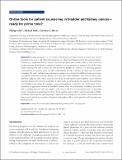| dc.description.abstract | Gauging prognosis is a key element when facing treatment decisions in cancer care. Several prognostic tools, such as risk tables and nomograms are at hand to aid this process. In the context of patient-centered care, prognostic tools are of great interest to caregivers and -providers alike, as they can convey sizeable amounts of information and provide tailored, accurate estimates of prognosis. Given the rising number of prognostic tools in cancer care over the last two decades, and similarly, ever increasing presence of the Internet, we aimed to assess how this would translate into the availability of online tools for patient counseling. We used a modified systematic review to evaluate the web-based availability, format, and content of prognostic tools for bladder and kidney cancer care. Our search identified a total of twenty-three tools, offered by eight providers, which assessed a total of six (bladder cancer) and five (kidney cancer) different outcomes. Despite the restricted availability of online tools, we observed that the majority showed limited user-friendliness (including, for example, a statement/explanation of intended use, visualization of data, availability as application software for handheld devices). Only one tool included modifiable risk factors such as smoking behavior and body weight. Lastly, none of the tools incorporated genomic or molecular markers or treatment associated quality of life. Taken together, online tools for patient counseling in bladder and kidney cancer care are only beginning to align with the growing need in clinical reality. Further and future avenues include incorporation of health-related quality of life as well as genomic and biomarkers into prediction tools. | en |


